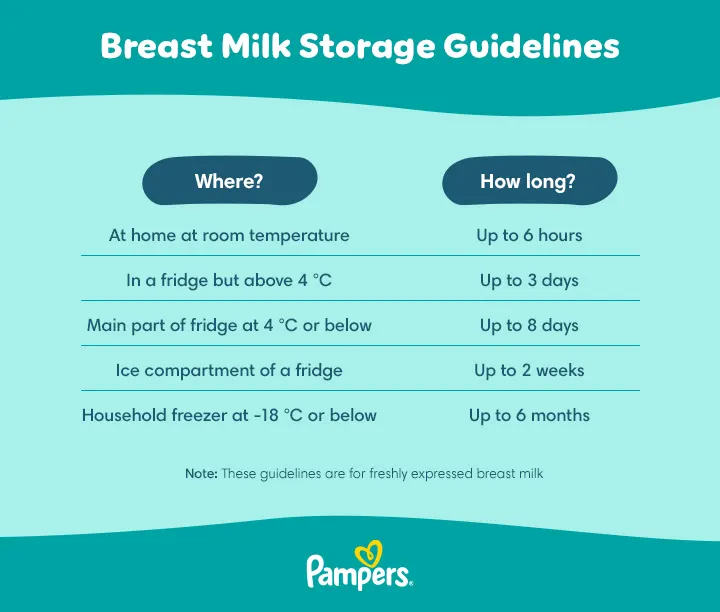
How to Store Breast Milk Safely
There are many reasons you might want to collect and store your breast milk. Read on to learn how to collect and safely store breast milk, and how to defrost and warm it up when it’s time to give it to your little one.
The Benefits of Storing Some Breast Milk
There are lots of reasons to express and store breast milk. For example:
How to Collect Breast Milk
There are three main ways to express your milk:
What Containers to Use
You can store your freshly expressed breast milk in any sterile airtight container, but breast milk storage cups, bottles or bags designed specifically for this purpose might have useful extra features, such as:
How to Store Breast Milk
When storing your breast milk, follow these easy steps:
Portioning the Breast Milk for Storage
It’s best to store milk in small portions, especially if you’re planning on freezing the breast milk. That way it’ll be easy to defrost just what you need.
The definition of a ‘small portion’ can change with time, as the amount your baby drinks at each feed increases as he or she gets older. For example, at three days old your little one only needs around 22 to 27 millilitres at every feed, but by the age of 1 month this may already have risen to around 80 to 150 millilitres per feed.
Hygiene Guidelines
It’s important that the items you use to pump and store your breast milk are very clean to help prevent transmitting bacteria to the breast milk and to your baby.
Before using your breast pump make sure to sterilise all its parts, including the storage bottles and any other parts that come into contact with your breasts or the milk.
Sterilise by boiling the parts for at least 10 minutes or use an electric steriliser or a sterilisation container that can be placed in a microwave oven. Alternatively, soak the parts in a cold-water sterilising solution for at least 30 minutes.
Always follow the manufacturer’s instructions for sterilising and follow the recommended boiling or sterilising time in case it’s a little different for the product you have. Let sterilised items cool down after boiling or steaming and handle them with caution.
After you use the pump, every time, make sure to wash the parts in hot, soapy water, or in the dishwasher if the parts are dishwasher safe.
The same hygiene guidelines apply to the bottles or storage containers you use to store the breast milk. Check the instructions that come with the product for guidelines specific to it, just in case it’s a little different to the general guidelines we’ve described here.
Each time you use the pump or handle breast milk, wash your hands thoroughly first.
How Long Does Breast Milk Last in Storage?
How long you can store breast milk depends on the temperature you keep it at. As a general rule, the colder it is, the longer it lasts, but there are a few extra things to keep in mind:
Depending on where it’s kept, freshly expressed or pumped breast milk can be stored for the following lengths of time:
Defrosting Breast Milk
Follow these tips for thawing breast milk that’s been stored in the freezer:
How to Warm Chilled Breast Milk
Breast milk stored in the fridge, whether it’s been previously frozen or not, can be warmed up if you would like to give your baby warm milk.
Keep in mind, though, that breast milk doesn’t need to be given to your baby warm – it’s also OK to feed your baby breast milk that’s chilled or at room temperature if he or she prefers it like that.
Follow these steps to warm breast milk after storage in the fridge:
Is Stored Breast Milk Any Different From Fresh Breast Milk?
Breast milk that’s been in storage, either in the refrigerator or thawed from the freezer, can look different from freshly expressed or pumped breast milk. It may even separate into a creamy layer and a more watery layer. This is completely normal. Gently shake the milk storage bottle or container to mix it back together.
If your freezer has an automatic defrost cycle, the frozen milk may seem frothy after you thaw it out. In this case, as long as the defrosted breast milk doesn’t smell sour, it’s usually OK. If you do notice a sour or rancid smell, throw the milk away.
FREQUENTLY ASKED QUESTIONS
The Bottom Line
For busy mums like you, expressing or pumping breast milk and then storing it can be a lifesaver.
Having breast milk in storage can make it easier to keep up with your baby’s feeds – even during periods of cluster feeding – and allows you to share feeding duties with others.
Using the info in this article and by giving it a try, you’ll soon get the hang of storing, defrosting, and reheating breast milk and it will become a natural part of your life with your little one.
How we wrote this article The information in this article is based on the expert advice found in trusted medical and government sources, such as the National Health Service (NHS). You can find a full list of sources used for this article below. The content on this page should not replace professional medical advice. Always consult medical professionals for full diagnosis and treatment.
- NHS: Expressing and storing breast milk
- NHS: Breastfeeding and expressing milk for your baby at GOSH
- NHS: Expressing breast milk
- NHS: The best start - A guide to expressing and breastfeeding your premature baby
- NHS: Infant Feeding Support
- NHS: Bump, Baby & Beyond
- NHS: Hand Expressing
- NHS: Feeding Your Baby
- NHS: Guide to breastfeeding
- NHS: Mastitis
Read more about Newborn Baby
Related Articles
Join Pampers Club and get:















